Lab Ventilation
- Pest Management
- Fire Plan Review and Inspection
- Building Codes Enforcement
- ADA Assessment
- Applicable Building Codes
- Building Emergency Coordinators
- Certificate of Completion or Occupancy
- Chartfield Form Codes Permits
- Inspections
- Permit Application Process
- PERMIT APPLICATIONS AND FORMS
- Permit Fee Schedule
- Permit Instructions
- Plan Submittal Guidelines
- Temporary Structures on Campus – Including Tents
- Insurance and Risk Management
- Occupational Medicine
- Industrial Hygiene & Occupational Safety
- Ergonomics
- Camps
- Drones/UAS
- Building and Contents
- Boating & Dive Safety
- Automobile
- Report Lab Closeout
- Radiation Safety
- Hazardous Waste Management
- Chemical and Lab Safety
- Standard Operating Procedures
- Safety Surveys
- Peroxide Forming Compounds
- New Labs, Moving Labs & Closeouts
- Nanoparticles
- Minors and Visitors in the Lab
- Lessons Learned
- Lab Ventilation
- Lab Signage
- Lab Safety Manual
- Hydrofluoric Acid
- Greenhouse Safety
- First Aid Kit Info
- Equipment Purchase Approval
- Equipment Decontamination
- DEA – Controlled Substances
- DBPR – Pharmaceutical Products
- Cryogens
- Compressed Gas
- Chemical Storage and Management
- Chemical Spills
- Chemical Safety Information
- Chemical Inventory
- Chemical Hygiene Plan
- Chemical Exposures
- Acids That Deserve Special Attention
- Biological Safety
- Vaccination Policy for Research Personnel
- Shipping and Transport of Biological Materials
- Select Agents
- Research Involving Flying Insects
- Recombinant & Synthetic Nucleic Acids
- Plant Research
- NIH Guidelines Flowchart
- BloodBorne Pathogen Program
- Biohazardous Waste Disposal
- Biohazard Project Registration
- Autoclaves
- Acute Biological Toxins
- Lab Safety & Research Services
- Clinic Safety
- Chemical Safety
- Animal Research Safety
Ventilation Systems
Ventilation systems for laboratories are normally designed to provide 6 – 12 air changes per hour at a slightly negative pressure relative to hallways and office space. It is important to keep lab doors and windows closed as much as possible for proper pressure balance and ventilation of the lab.
Fume Hoods
Chemical fume hoods are intended to remove vapors, gases, and dusts of toxic, flammable, corrosive or otherwise dangerous materials. It is important for lab staff to understand how the chemical fume hood in the lab functions.
Proper Use of Fume Hoods
With the sash lowered to the indicated level for proper airflow, laboratory fume hoods can also afford workers protection from such hazards as chemical splashes or sprays and fires. Sash heights are posted and updated annually on the EH&S sticker attached to each hood.
If the hood’s low airflow alarm is sounding, the lab staff must immediately end their work in the hood, close all chemical containers and close the sash. Contact the appropriate maintenance department to have the ventilation system repaired. Do not ignore or disconnect any fume hood alarm.
The use of heated or evaporating perchloric acid requires a specialty fume hood to avoid potentially explosive conditions. Do not use heated perchloric acid before consulting with and obtaining approval from EH&S.
Fume Hood Decommissioning
All projects including the removal of a chemical fume hood must be submitted to EH&S Building Codes Enforcement for plan review and permitting. This review will ensure that all relevant building and fire codes are addressed during the project. Work must not start until EH&S Laboratory Safety Program has received the decontamination form.
For more information access the Chemical Fume Hood Decommissioning Guide.
Common Engineering Controls in Animal Research
The following information is available as a reference for writing SOPs for the use of hazardous materials in rodents. Contact EH&S regarding SOPs for chemical use in other types of animals. Animal work at the University of Florida covers a wide variety of disciplines and it is the responsibility of the Investigator to ensure that their studies are conducted safely, including the use of Personal Protective Equipment (PPE) and proper Engineering Controls (i.e. hoods) for study staff and animal husbandry staff.
Down Draft Tables
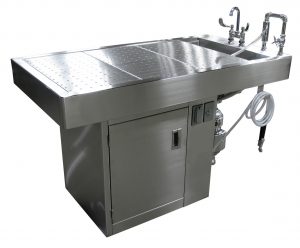
- Description: Provides personnel protection by pulling air away from the user, through the work surface and out of the facility either through its own exhaust system or through ducts in the facility exhaust. No air is recirculated into the room. Annual testing by outside contractor tests for a calculated average velocity of 50-100 fpm.
- Chemical Safety Application: Use with chemicals that volatilize or release vapor (such as formaldehyde/paraformaldehyde). These units provide no splash protection.
- Common Use: Necropsies and perfusion procedures.
- Found In: Available for use in the Communicore, Biomedical Sciences, and McKnight Brain Institute animal housing facilities. Also, in some private lab spaces.
Horizontal Laminar Flow Hood (a.k.a “clean bench)
- Description: Air is passed through a HEPA filter, over the work surface, and either exhausts straight out toward the user or is pulled into a grate in the front of the work surface. Units that pull air in through the grate provide some personnel protection but are not sufficient for use with biological or chemical hazards.
- Chemical Safety Application: Since units only provide product protection and do not provide any or sufficient personnel protection, horizontal laminar flow hoods are not safe for use with any chemicals.
- Common Use: Where a clean air environment is needed for smaller items such as particle sensitive electronic devices or in pharmaceutical sterile compounding.
- Found In: Only a few of these units remain in use in ACS facilities. They are used in animal housing rooms to provide protection to small animals from outside contaminants.
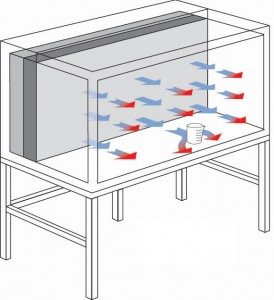
Exhausts Toward User
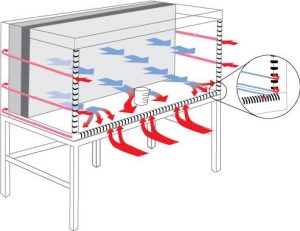
Exhuasts into Grate
Animal Transfer Stations (ATS)
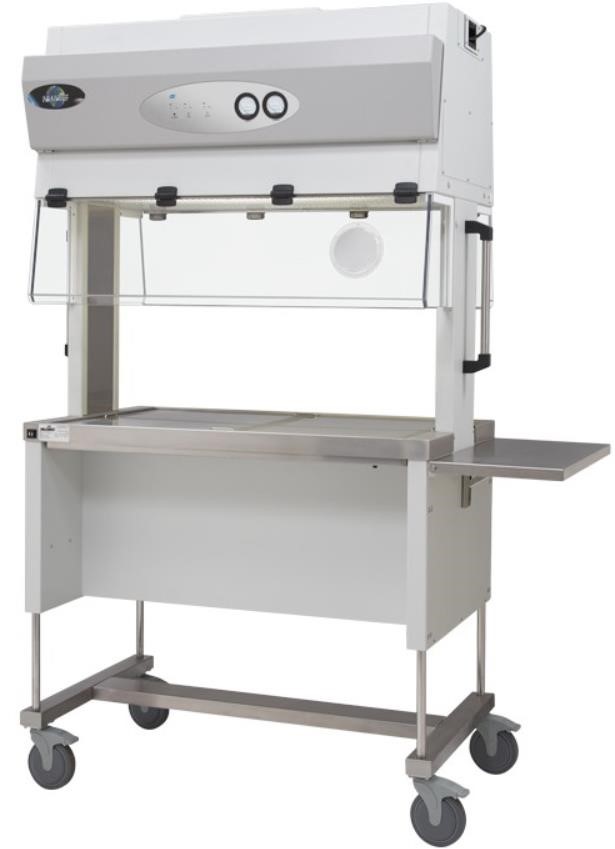
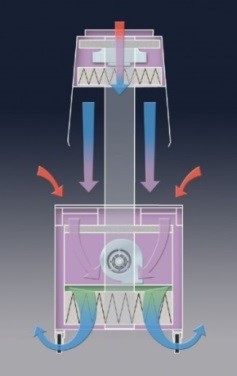
Airflow Diagram
- Description: ATSs are essentially laminar flow hoods designed to protect research animals from contaminants and provide allergen control for personnel protection.
- Offers Iso Class 4 protection for research animals from environmental contaminants.
- Chemical Safety Application: Not safe to use with volatile anesthetics or chemicals. Injectable solutions pre-loaded into syringes may be used.
- Common Use: Cage changing procedures, animal manipulations and sample collection, health checks and veterinary treatments.
- Found In: Found in almost all rodent housing rooms in ACS facilities.
Biological Safety Cabinet (BSC)
- Description: BSCs are designed to provide personnel, environmental, and product protection from biologicals when appropriate practices and procedures are followed. The HEPA filters within protect personnel and environment from particulate hazards. There are three kinds of BSCs, but UF only has Class II and Class III BSCs.
Class II Type A2
- Description: Supply air is brought in through a HEPA filter, passed vertically over the work surface, collected in the front and back air grates, and either passed through the exhaust HEPA and recirculated back into the animal room (30%) or passed back through the supply HEPA and recirculated within the BSC. Units may be canopy connected to facility exhaust system to capture exhaust and facilitate its removal from the room.
- Chemical Safety Application: Like the ATS, the Class II Type A2 BSC is safe to use with injectable solutions pre-loaded into syringes only. Not safe to use with volatile anesthetics or chemicals because HEPA filters do not capture volatile chemical vapors. Also, the majority of the air within the cabinet is continuously recirculated, allowing vapors to build.
- Common Use: Cage changing procedures, animal manipulations sample collection, health checks, and veterinary treatments where biohazards are a concern.
- Found In: Found in ABSL-2 small animal housing rooms and some procedure rooms.
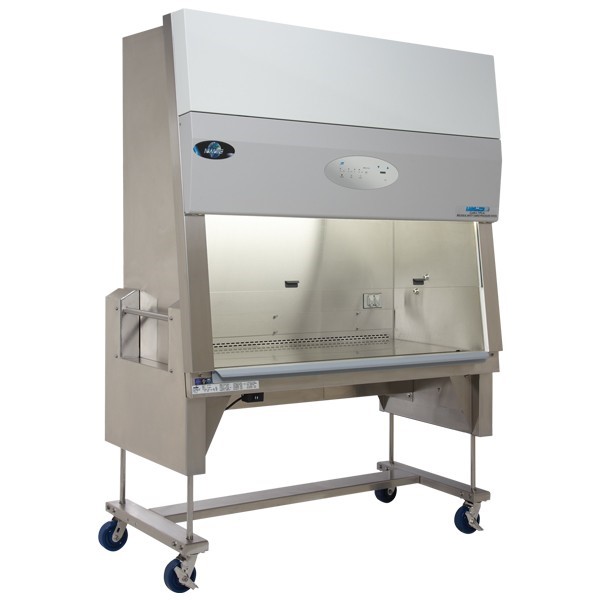
BSC Class II Type A2
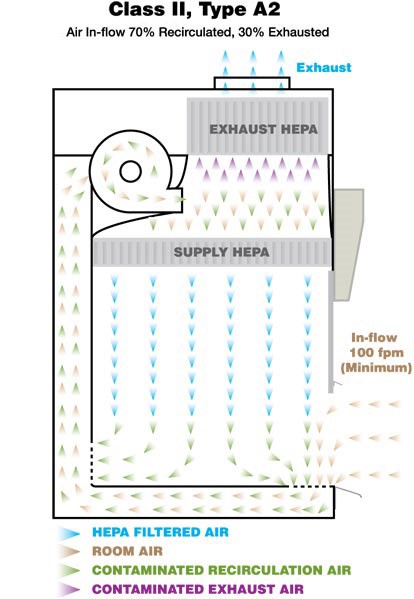
Airflow Diagram
Class II Type B2
- Description: Supply air is brought in through a HEPA filter, passed vertically over the work surface, collected in the front and back air grates, then passed through the exhaust HEPA filter. 100% of the air is exhausted. These units are directly connected to the facility exhaust system for discharge of all exhaust outside.
- Chemical Safety Application: Since the cabinet is 100% exhausted and directly connected to the facility exhaust system, these units are safe to use with volatile anesthetics and other vapor producing chemicals.
- Common Use: Cage changing procedures, animal manipulations sample collection, health checks and veterinary treatments.
- Found In: A limited number of animal rooms in the Biomedical Sciences, Cancer/Genetics Research Complex, and Communicore buildings.
Class III BSC
- Description: Class III hoods are gas-tight, essentially a sealed glovebox. Supply air is brought in through a HEPA filter then passed through two exhaust HEPA filters in series. 100% of the air is exhausted. These units are directly connected to the facility exhaust system.
- Chemical Safety Application: Since the cabinet is 100% exhausted and directly connected to the facility exhaust system, these units are safe to use with volatile anesthetics and other vapor producing chemicals.
- Common Use: For work with RG-3 and RG-4 pathogens.
- Found In: Class III hoods are only available in the BSL-3/ABSL-3 facilities on campus.
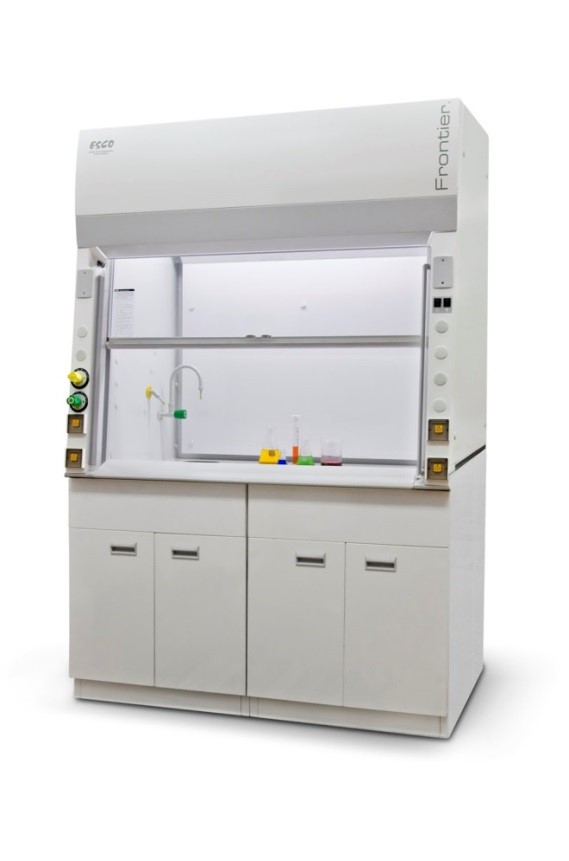
Chemical Fume Hood
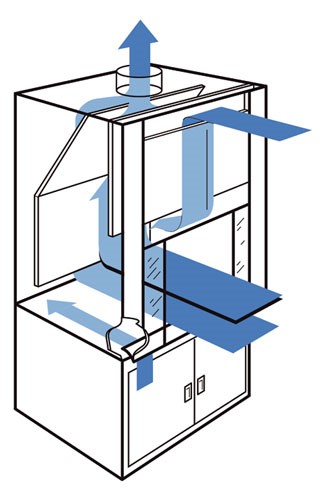
Airflow Diagram
Chemical Fume Hoods
- Description: Intended to remove vapors, gases, and dusts of toxic, flammable, corrosive, or otherwise dangerous materials.
- Chemical Safety Application: designed to work with all types of chemicals.
- Common Use: any procedure that uses a chemical that releases vapor, gas, or toxins.
- Found In: While common in research laboratories, chemical fume hoods are extremely rare in UF ACS facilities.


